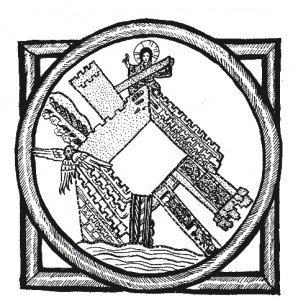In the pub after the Kingston Round Table of Inventors meeting this evening, a nice guy from Kingston Uni told me that he had recently had two “dry migraine” attacks, and that he was waiting for the results of the follow-up CT scan. This reminded me that I had a German Voynich explanation (i.e. not quite a theory, or perhaps a meta-theory) to post about here…
In Gerry Kennedy & Rob Churchill’s book, they float the hypothesis that the Voynich Manuscript might possibly have been written by someone suffering a prolonged (months- or years-long) migraine attack; and point to the streams of stars and the repetitive series of nymphs as vaguely supporting (if far from smoking-gun causal) evidence. However, nobody (to my knowledge) really took the notion particularly seriously until German blogger Markus Dahlem decided to carry their conceptual baton a little further in the general direction of… Hildegard of Bingen.
Might the castle in the nine-rosette page actually be a representation of the Aedificium, the piously hallucinatory City of God drawn by Hildegard in her Zelus Dei or her Sedens Lucidus? Are the Voynich’s stars simply “showers of phosphenes” cascading wildly through Hildegard’s retinal circuits?
I saw a great star most splendid and beautiful, and with it an exceeding multitude of falling stars which with the star followed southwards … And suddenly they were all annihilated, being turned into black coals… and cast into the abyss so that I could see them no more.
To me, the fact that Hildegard is discussed by both Charles Singer and Oliver Sacks is no more than an expression of her outlierness: she not only had the repeated experience of migraine auras, but also had the literary imagination to stitch that into her religious worldview. Basically, I’m pretty sure that there is almost no real chance that the author of the Voynich Manuscript was a migraine sufferer.
And besides, Hildegard drew square merlons in her City of God, not swallow-tail merlons. D’oh! 🙂
